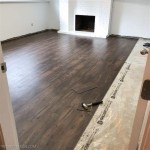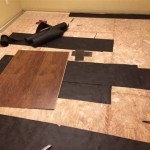Essential Aspects of Laying Vinyl Plank Flooring on Uneven Concrete
Vinyl plank flooring is increasingly popular due to its durability, affordability, and ease of installation. However, installing it on uneven concrete can present some challenges. This article will provide a comprehensive guide on how to successfully lay vinyl plank flooring on uneven concrete, ensuring a professional and long-lasting finish.
Assessing the Unevenness
Before beginning the installation, it is crucial to assess the extent of the unevenness of the concrete. Use a level or straightedge to determine the high and low spots. Mark these areas clearly for reference during the preparation and installation process.
Preparing the Concrete Surface
To ensure a solid and level base for the vinyl planks, the concrete surface must be properly prepared. Start by removing any dirt, debris, or old flooring. Repair any cracks or holes using a concrete patching compound. If the unevenness is significant, self-leveling concrete may be necessary to achieve a smooth and level surface.
Using an Underlayment
An underlayment is essential for providing a cushion between the concrete and the vinyl planks. It compensates for minor unevenness and helps reduce noise and moisture transmission. Choose an underlayment specifically designed for vinyl plank flooring and install it according to the manufacturer's instructions.
Applying Leveling Compound
For more substantial unevenness, a leveling compound can be applied over the underlayment. This self-leveling material will flow into the low spots and create a smooth, flat surface. Follow the manufacturer's instructions for mixing and pouring the leveling compound.
Installing the Vinyl Planks
Once the surface is level, start installing the vinyl planks according to the manufacturer's guidelines. Begin by measuring and cutting the planks to fit the room. Use a utility knife or a specialized vinyl cutter for precise cuts. Stagger the planks to create a natural-looking appearance and maintain stability.
Adhesive or Floating Installation
Vinyl plank flooring can be installed using adhesive or a floating method. With the adhesive method, the planks are glued directly to the prepared concrete surface. This provides a secure and durable bond but requires more time and effort. The floating method involves locking the planks together and placing them over the underlayment. This is a quicker and easier installation, but the planks may not be as securely attached.
Expansion Gaps
Expansion gaps are necessary around the perimeter of the room and around obstacles such as doorways or columns. These gaps allow the flooring to expand and contract with changes in temperature and humidity, preventing buckling or warping. Use spacers to maintain a consistent gap during installation.
Finishing Touches
Once the vinyl planks are installed, it is essential to finish the project with baseboards, moldings, or transition strips. These finishing touches will conceal any gaps, provide a professional appearance, and protect the edges of the flooring.
By following these essential aspects, you can successfully lay vinyl plank flooring on uneven concrete, creating a durable, attractive, and long-lasting floor in your home or commercial space.

Vinyl Plank Flooring On Uneven Concrete

10 Beginner Mistakes Installing Vinyl Plank Flooring

Should We Be Concerned About Vinyl Plank Installed Over Uneven Floors

Vinyl Plank Flooring On Uneven Concrete

How Can I Prepare Uneven Concrete Basement Floor For Vinyl Planks Home Improvement Stack Exchange

How Can I Prepare Uneven Concrete Basement Floor For Vinyl Planks Home Improvement Stack Exchange

Flooring Is This Small Slope A Problem Installing Vinyl Plank Home Improvement Stack Exchange

Vinyl Planks Installed Over Uneven Floor How Do I Fix It Now Doityourself Com Community Forums

How Can I Prepare Slightly Uneven Tiled Floor For Vinyl Planks Home Improvement Stack Exchange

Easy Ways To Install Vinyl Plank Flooring On Concrete
See Also







